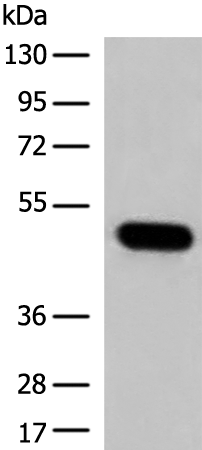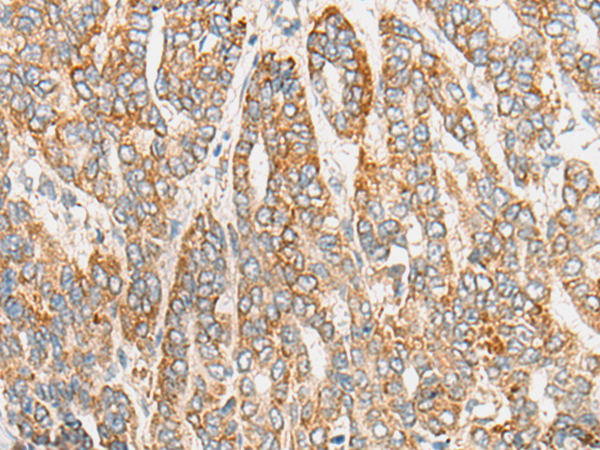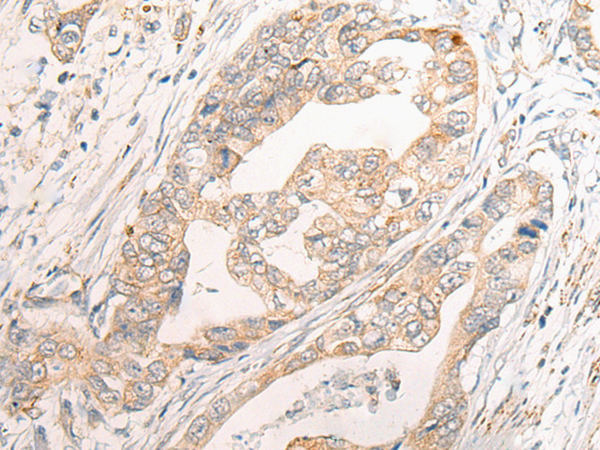


| WB | 咨询技术 | Human,Mouse,Rat |
| IF | 咨询技术 | Human,Mouse,Rat |
| IHC | 1/20-1/100 | Human,Mouse,Rat |
| ICC | 技术咨询 | Human,Mouse,Rat |
| FCM | 咨询技术 | Human,Mouse,Rat |
| Elisa | 1/5000-1/10000 | Human,Mouse,Rat |
| Aliases | TFP; RNF23; TRIM39B |
| WB Predicted band size | 60 kDa |
| Host/Isotype | Rabbit IgG |
| Antibody Type | Primary antibody |
| Storage | Store at 4°C short term. Aliquot and store at -20°C long term. Avoid freeze/thaw cycles. |
| Species Reactivity | Human, Mouse, Rat |
| Immunogen | Fusion protein of human TRIM39 |
| Formulation | Purified antibody in PBS with 0.05% sodium azide and 50% glycerol. |
+ +
以下是3篇关于TRIM39抗体的参考文献及其简要摘要:
---
1. **"TRIM39 regulates cell cycle progression and DNA damage responses via stabilizing p21"**
- **作者**: Zhao et al.
- **摘要**: 研究利用TRIM39抗体揭示其通过泛素化调控p21蛋白稳定性,影响G1/S期转换及DNA损伤应答,表明TRIM39在细胞周期调控中的关键作用。
2. **"TRIM39 inhibits apoptosis by stabilizing IAPs through ubiquitination pathway"**
- **作者**: Li et al.
- **摘要**: 通过免疫沉淀(使用TRIM39抗体)发现TRIM39与凋亡抑制蛋白(IAPs)相互作用,并通过泛素化修饰维持IAPs稳定性,从而抑制caspase依赖性细胞凋亡。
3. **"TRIM39 deficiency sensitizes cancer cells to chemotherapy via modulating NF-κB signaling"**
- **作者**: Wang et al.
- **摘要**: 研究通过Western blot(TRIM39抗体验证敲除效率)证明TRIM39缺失通过增强NF-κB信号通路促进化疗药物诱导的肿瘤细胞死亡,提示其作为癌症治疗潜在靶点。
---
以上文献展示了TRIM39在细胞周期、凋亡调控及癌症治疗中的分子机制,相关抗体被用于蛋白互作、表达水平检测及功能研究。如需具体DOI或期刊信息,可进一步补充查询。
TRIM39 (Tripartite Motif-Containing Protein 39) is a member of the TRIM protein family, characterized by conserved RING, B-box, and coiled-coil domains. It functions as an E3 ubiquitin ligase, playing roles in ubiquitination-mediated protein degradation and signaling regulation. TRIM39 is involved in diverse cellular processes, including cell cycle progression, apoptosis, DNA damage response, and immune regulation. Studies suggest it interacts with proteins like CDK1/cyclin B1 to influence mitotic entry and with p53 to modulate apoptosis. Its role in cancer is context-dependent, acting as a tumor suppressor in some contexts by promoting apoptosis or cell cycle arrest, while potentially supporting tumor survival in others through stress adaptation pathways.
TRIM39 antibodies are essential tools for detecting TRIM39 expression in research applications such as Western blotting, immunohistochemistry, and immunofluorescence. They help elucidate TRIM39’s tissue-specific expression patterns, subcellular localization (primarily nuclear), and regulatory mechanisms. Recent interest focuses on its potential as a therapeutic target, particularly in cancers with dysregulated ubiquitination pathways. Commercial TRIM39 antibodies are typically validated for specificity using knockout cell lines or siRNA-mediated knockdown. Researchers should verify antibody cross-reactivity with homologous TRIM family members, as sequence similarities may lead to off-target detection.
×